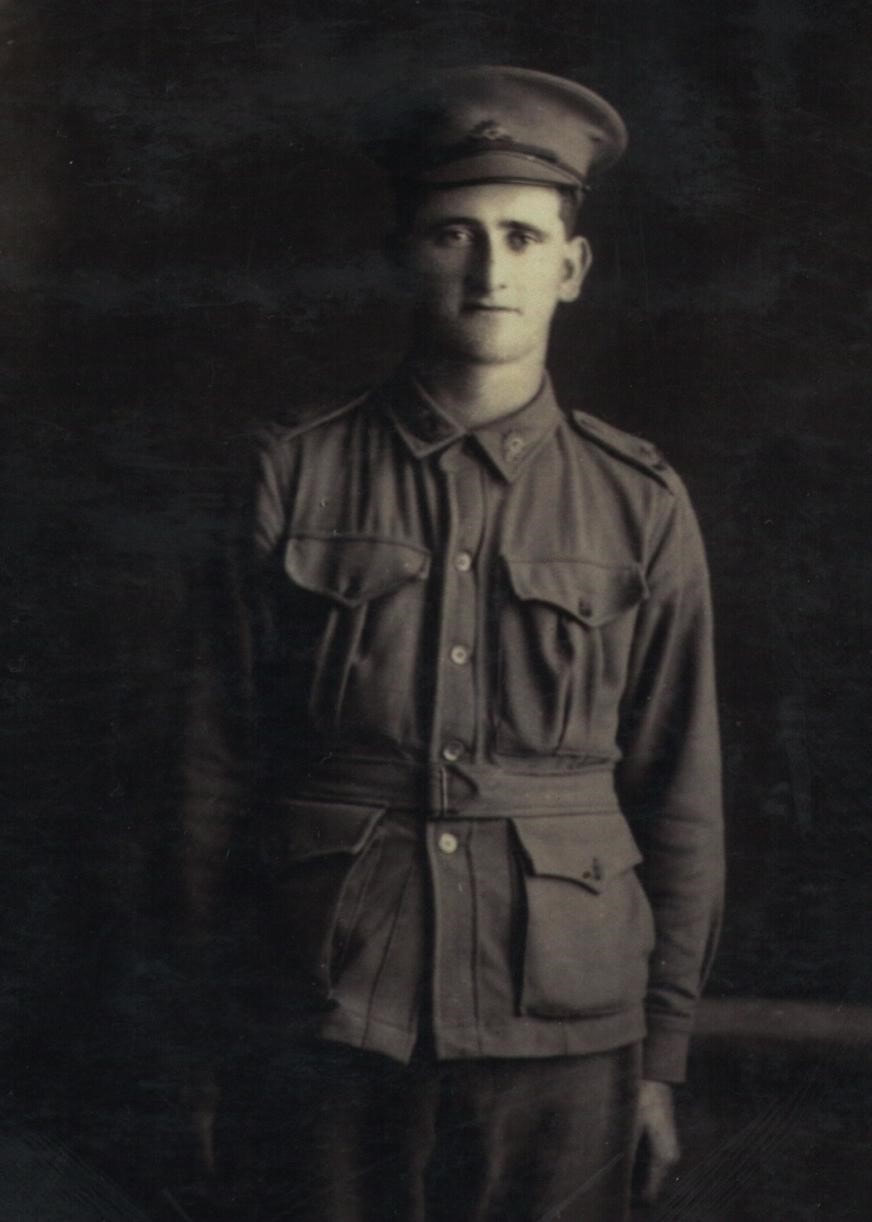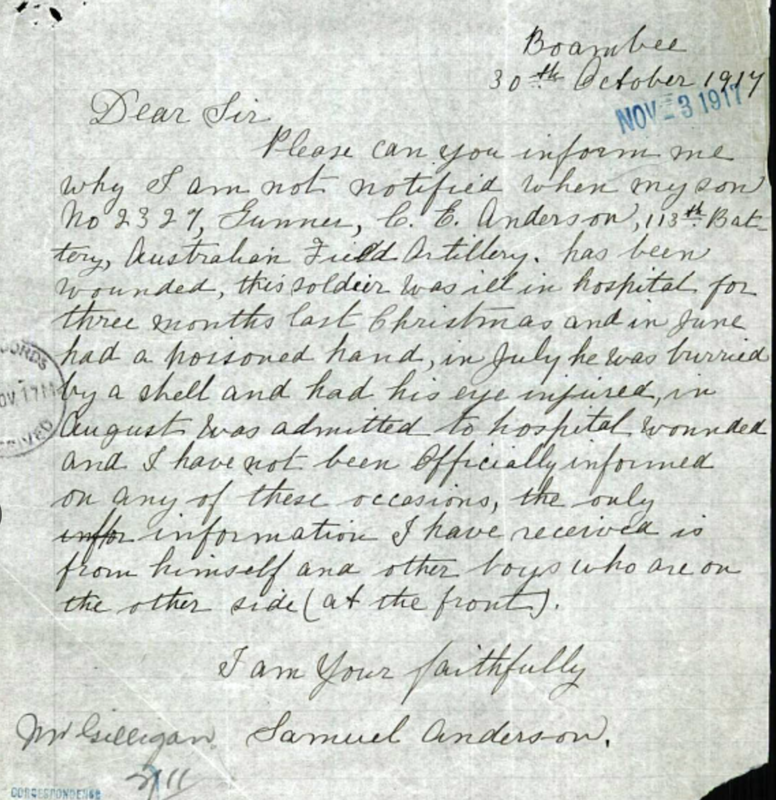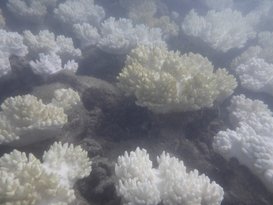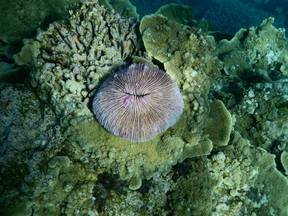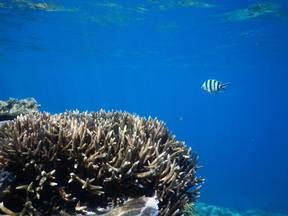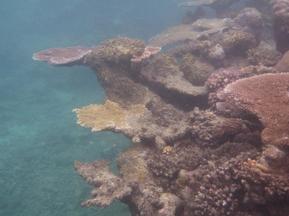On 17th September he was admitted to the 5th Field Ambulance, Rest Gully, Gallipoli and was then transferred to the 1st Australian Casualty Clearing Station. He was suffering from Otitis Media, a middle ear infection, but it forced him to be hospitalised for a considerable time – 26 days, and it developed into an ear abscess. He embarked at Dardenelles on the HS Mahena, and disembarked at Malta where he was admitted to Hamrun Military Hospital on 18th October 1915. Below is a transcript of correspondence between Charles' father Samuel and military personnel. It mostly relates to his injuries and hospitalisations (gassing, eye injury, etc), but also the circumstances around his medal towards the end. It gives a good picture of the frustrations faced by families in trying to get information about their loved ones. ____________________ Samuel Anderson Boambee, Via Coffs Harbour (NSW) Regret reported son Private C.E.Anderson disembarked for Malta Hospital ship Maheno 23rd September slightly sick. Will promptly advise if anything further received. Base Records 9/10/15 ____________________ Mr. S. Anderson Boambee, via Coffs Harbour Australian Imperial Force Base Records Office A.I.E.F. Victoria Barracks, Melbourne 2nd December 1915 Dear Sir, The following is an extract from a Nominal Roll of sick and wounded received by post, dated 28/9/15 who landed at Malta 23rd September from hospital ship “Maheno”, No. 2327 Private C. E. Anderson, 1st Battalion, suffering from abscess ear. Any further reports received will be promptly communicated to you. Yours faithfully, J.M. Lean Captain Officer i/c Base Records. ____________________ Mr. S. Anderson Boambee, via Coffs Harbour Australian Imperial Force Base Records Office A.I.E.F. Victoria Barracks, Melbourne 6th January 1916 Dear Sir, The following is an extract from a Nominal Roll of Officers, Non-Commissioned Officers and Men, received by post, dated 18/11/15 who embarked at Malta for Mudros on H.T. “Hurno” on 15/11/15, No. 2327 Private C.E. Anderson, 1st Battalion, fit for active service. Any further reports received will be promptly communicated to you. Yours faithfully, J.M. Lean Captain Officer i/c Base Records. ____________________ Boambee 30th October 1917 Dear Sir Please can you inform me why I am not notified when my son No 2327, Gunner, C. E. Anderson, 13th Battalian, Australian Field Artillery, has been wounded. This soldier was ill in hospital for three months last Christmas and in June had a poisoned hand, in July he was buried by a shell and had his eye injured, in August was admitted to hospital, wounded and I have not been officially informed on any occasions. The only information I have received is from himself and other boys who are on the other side (at the front). I am yours faithfully, Samuel Anderson ____________________ Mr. S. Anderson Boambee, via Coffs Harbour 8th November, 1917 Dear Sir, In reply to your letter of the 30th, I have to advise that no report has been received here to that effect that your son No. 2327, Gunner C.E. Anderson, 13th Field Artillery Brigade, has been recently wounded, but, if you can forward to this office authentic documentary evidence, such as a letter containing this information, enquiries will, if warranted, be instituted and the result communicated to you. Yours faithfully, Major. Officer i/c Base Records. ____________________ 8th March 1918 Honour or Reward: D.C.M. Recommended by: A.J.Bessel-Browne; C.R.A. 5th Aust. Div. Action for which commended: This Gunner has served with his Battery continuously during the period 22nd September 1917 to 25th February 1918. While it was in action at Westhork, East of Ypress, he was gassed on two occasions but declined to leave the position. He is an excellent layer, and his presence was very valuable on account of the heavy casualties. On the afternoon of the 15th October 1917 a neighbouring battery position was shelled by an 8th Howitzer Battery, direct hits smashing a pill-box, and severely wounding three of the occupants. Although this fire continued, Gunner Anderson, assisted by another gunner, without hesitation, went to this pill-box and succeeded in getting the wounded men out and carrying them to a place of safety. In doing this, he showed a total disregard of personal danger and had many narrow escapes from bursting shells. His conduct during the whole time his Battery was in action has been excellent, and by his courage and devotion to duty he has set a splendid example, which is deserving of special recognition. Signed J.T. Hoebs Major-General Commanding 5th Australian Division ____________________ 16th July 1918 Dear Sir, I now beg to advise you that Private C.E.Anderson has been reported gassed (classed as wounded). His postal address will be No. 2327 Gunner C.E. Anderson “D.C.M.” 13th Field Artillery Brigade, Australian Imperial Force, Abroad. In the absence of further reports it is to be assumed that satisfactory progress is being maintained, but anything later received will be promptly transmitted it being clearly understood that if no further advice is forwarded this department has no more information to supply. Yours faithfully, JMLean Major, Officer in Charge, Base Records. ____________________ Bonville 25th July 1918 Sir I have received information through the Base Record Office stating the No 2327, Gunner C.E. Anderson D.C.M. has been reported gassed. Has any information come through previously with regard to him winning this medal. If so we have never received it. His address is now given to me as 13th Field Artillery Brigade whereas before it was 113th Howitzer Battery. Please inform me if this is a misprint. And kindly oblige, please note change of address S Anderson Bonville North Coast New South Wales ____________________ Boambee Via Coffs Harbour Samuel Anderson Now reported Gunner Charles Anderson admitted Fourteenth Stationary Hospital. Boulogne France sixth July. Gassed. Dangerous. Further Progress report expected. Base Records 25/7/1918 ____________________ Mr Samuel Anderson Boambee Via Coffs Harbour Now reported Gunner Charles Anderson pronounced out of danger. Base Records 31/7/18 ____________________ 1st August 1918 Dear Sir, I now beg to advise you that Gunner C.E.Anderson”D.C.M.” has been reported transferred to Endell Street Military Hospital, London, England, on 17/7/18 and is now removed from seriously ill list. His postal address will be No. 2327 Gunner C.E. Anderson “D.C.M.” 13th Field Artillery Brigade, (late 1st Battalion) Australian Imperial Force, Abroad. In the absence of further reports it is to be assumed that satisfactory progress is being maintained, but anything later received will be promptly transmitted it being clearly understood that if no further advice is forwarded this department has no more information to supply. Yours faithfully, JMLean Major, Officer in Charge, Base Records. ____________________ 7th August 1918 Mr S. Anderson Bonville, North Coast, NSW Dear Sir, With reference to your communication of 25th July, I have to inform you that beyond the fact that the letters “D.C.M.” were quoted after your son’s name in the cable reporting his casualty, nothing further is known of the award. Notification will, no doubt, come to hand at a later date by mail, when you will be officially advised. I would point out that the 113th Howitzer Battery is a portion of the 13th Field Artillery Brigade, and if you so desire you can address the soldiers’ mail matter as under:- No. 2327 Gunner C.E. Anderson 113th Howitzer Field Artillery Brigade (late 1st Battalion) Australian Imperial Force, Abroad Yours faithfully, Major Officer i/c/ Base Record P.S. Your change of address is noted. ____________________ 9th August 1918 Dear Sir, I now beg to advise you that Gunner C.E.Anderson “D.C.M.” has been reported convalescent. His postal address will be No. 2327 Gunner C.E. Anderson “D.C.M.” 13th Field Artillery Brigade, Australian Imperial Force, Abroad. In the absence of further reports it is to be assumed that satisfactory progress is being maintained, but anything later received will be promptly transmitted it being clearly understood that if no further advice is forwarded this department has no more information to supply. Yours faithfully, JMLean Major, Officer in Charge, Base Records. ____________________ Base Records Office Victoria Barracks Melbourne, 15th November 1918 Dear Sir I have much pleasure in forwarding hereunder copy of extract from Second Supplement No. 30716 to the “London Gazette” dated 3rd June, 1918, relating to the conspicuous services rendered by the undermentioned member of the Australian Imperial Force. AWARDED THE DISTINGUISHED CONDUCT MEDAL No. 2327 Gunner C. E. Anderson The above has been promulgated in “Commonwealth of Australia Gazette” No.173 dated 7th November 1918. Yours faithfully Capt. For Major, Officer i/c/ Base Records. Distinguished Conduct Medal 'For conspicuous gallantry and devotion to duty. He was severely gassed on two occasions, but declined to leave his post, and on another occasion he went to the rescue of some wounded in a 'pill box" that had been smashed by an 8 in. shell and was still under heavy fire. In spite of great difficulty and danger, with the aid of another gunner he extricated the wounded and carried them to a place of safety. He has always set an example of great courage and devotion to duty that is worthy of the highest praise.' Source: 'Commonwealth Gazette' No. 31 Date: 4 March 1919 ____________________ Samuel Anderson Bonville (NSW) No recent report Regarding son. Assumed with unit. Base Records 22/3/19 ____________________ Charles was awarded the Distinguished Conduct Medal (DCM). He was presented with the award by King George V at Buckingham Palace. He married an English nurse named Edith Mills who had cared for him while he was in hospital after being gassed.
23rd July 1919 Charles returned to Australia, and received the War Pension, but went on to have great success in dairy farming and breeding cattle.
0 Comments
There is a huge amount of information available about coral reef health and in particular the mass coral bleaching events that have occurred over the past two years. Two of my previous posts are linked below, but if you scroll to the bottom of the page there are a range of other articles, reports and websites regarding coral bleaching that you might find useful.
Previous posts: Mass coral bleaching events Coral bleaching - reef resilience Students should define the following key terms: - acclimatise - connectivity - recruit - adaptation - natural selection - symbiotic - zoozanthallae - parasite - photosynthesis Answer the questions below. Conduct internet research to find articles and reports which support your answers.
Resources: Coral bleaching - GBRMPA Coral bleaching and the Great Barrier Reef - ARC CoE Coral bleaching: Extreme heat pushes parts of the Great Barrier Reef beyond recovery - ABC Coral bleaching events - AIMS Great Barrier Reef: a "hopping hotspot" - Australian Geographic The changes in temperature and associated bleaching are resulting in a different mix of species on the reef. This will impact reefs in the long term.
Loss of species Fish, whales, dolphins, sharks, rays and the many other organisms found in reefs rely on the complexity of the ecosystem for survival. Some fish rely on the colour of the corals for camoflauge and the structure of the coral for hiding. Many organisms are unable to carry out normal functions and processes as a result of the increased ocean acidification associated with climate change. Shellfish are less able to create their shells due to increased pH. Slow growing corals will take 100-200 years to recover, meaning that the reef will not exist in the form that we have known it in the past. Dispersal of spawn Ocean warming impacts on the dispersal or coral spawn (eggs). Increased ocean temperatures result in a decline in the dispersal distance of coral spawn from the origin (parent coral) to the destination site. This change in dispersal patterns can impact on species' distribution, abundance or corals in particular areas and genetic diversity across reefs. Changes to dispersal patterns can also impact on the connectivity (interconnections) between different areas of the reef by limiting the areas of reef that particular coral species are located. Poleward shift of species Ocean warming can also result in a poleward shift of species from tropical zones to more temperate zones. Warmer waters are found further from the tropics and species are able to take advantage by increasing their range. In Western Australia, a species of wrasse - cheorodon rebuscens has started to shift its range with displacement of recruits south of its usual habitat. There is evidence of high recruitment at the temperate edge and no recruitment at the tropical edge. The range shift provides limited expansion opportunities, reducing resilience of the species. Irukandji are migrating further south on the Great Barrier Reef as a result of warmer waters and are also having longer seasons in other areas. There have been anecdotal reports of increases in reports of stinging and hospitalisations on islands within the Great Barrier Reef (e.g Fitzroy Island) and snorkellers are being strongly advised to wear stinger suits outside of usual peak Irukandji seasons. Irukandji and associated stingings have also been reported on western side of the southern tip of Frazer Island where they haven't previously been found. Symbiotic relationships Following bleaching events or even natural disasters, corals can become overgrown with algae, making it difficult for coral recruits to settle and grow. The mix species on a reef can impact on how resilient that particular reefs is. For example in Moorea in French Polynesia experienced high coral mortality in the 1980s. Recovery of the reef was enabled in part as a result of grazing fish such as parrot fish removing some of the algae in the process of eating corals. In this way the biodiversity of the reef contributed to high levels of resilience on the reef in comparison to some other reefs globally. The scale of the bleaching on GBR make it unlikely that these types of natural processes will have much of an impact on recovery. Below: A parrot fish on the outer reef, 2015.  I had the pleasure of hearing Professor Terry Hughes present as part of the Sydney Ideas talks being run by the University of Sydney. Professor Hughes is Centre Director at the ARC Centre for Excellence for Coral Reef Studies at James Cook University. I use the term "pleasure" because I am a big fan of his work, and think that some of the visual representations that he has created have been incredibly powerful in explaining coral bleaching to students, but actually the information presented was really quite depressing. Image left: Photograph of bleached corals at Fitzroy Island April 2017. Hughes described some of the main drivers of degradation of coral reefs: pollution, overfishing and climate change. He explained how overfishing had resulted in the reduction of stock sizes for different species in the past century, how pollution from inland activities resulted in coral mortalities and encroachment of different ecosystems like mudflats in areas previously thriving with corals. He went on to say that the scale and extent of these changes were being dwarfed by the immediate and irreparable changes being wrought by back to back bleaching events. Below right: Bleached coral on Fitzroy Island April 2017. Mass bleaching events have occurred in both 2016 and 2017 as a result of increased ocean temperatures. The bleaching is as a result of corals expelling their symbiotic algae. Coral bleaching tends to occur after the summer temperature maximum, and relates to where the hottest water is. In 2016 coral bleaching severely bleached the northern third of the Great Barrier Reef, the middle section was bleached to a lesser extent, but still quite severely, while the bottom third of the reef largely escaped bleaching in 2016. This was established by the surveying of 1160 reefs through 9000km of aerial surveys, and 75 hours of flying. The 2017 bleaching event impacted the central section of the GBR, while the bottom third is again largely unbleached. Cycle Debbie, a chance weather event, lowered temperatures in the southern part of the reef, which contributed to reducing bleaching in this section. The combination of both the 2016 and 2017 bleaching events has been extremely damaging. There have been reports that the recent cyclone that affected Queensland, Cyclone Debbie may play a role in reducing the impact of coral bleaching. It was reported in the Cairns Post that the cyclone would reduce ocean temperatures, bring cooler waters to the surface and increase cloud cover, thus reducing bleaching, providing stressed corals with an opportunity to recover. The Cairns Post reported that temperatures off Lizard Island had dropped by three degrees and that this would reduce the severity of bleaching. It also provided quotes from a free diver describing the amazing colours and marine life of the outer reef. In reality, as already stated Lizard Island and the top third of the Great Barrier Reef were already severely affected by bleaching in 2016 (well before Cyclone Debbie) and were again affected in 2017. In any case, the path of the cyclone was too far south to have any real impact on areas severely affected by bleaching. Will the Great Barrier Reef recover? There is a narrow opportunity for limited recovery, but the Great Barrier Reef as we know it (complexity, extent, etc) is already dead in many areas. It will continue to exist but with reduced biodiversity. Any real opportunities to protect the reef as it remains is reliant on halting temperature increases and stabilising the climate through reducing reliance on fossil fuels. With negotiations underway between the Australian Government and Adani for for the creation of the Marmichael mines this seems highly unlikely. For more detail on coral bleaching see my article in this term's GTA NSW HSC edition of the Bulletin. http://www.gtansw.org.au Symbiotic relationships Symbiosis is a long term relationship between two organisms. There are three types of symbiotic relationship: mutualism (where both organisms benefit), commensalism (where one species benefits, but there is no benefit or harm to the other species), and parasitism (where one organism benefits tot he detriment of the other). There are many examples of symbiosis on coral reefs. Corals and zooxanthallae The relationship between the corals and the zooxanthallae is beneficial to both. Corals provide the zooxanthallae with an environment suitable for survival. It is moist and the coral's waste gives energy to the zooxanthallae. Through the process of photosynthesis the zooxanthallae produce compounds that the coral use for food. Clownfish and Sea Anemones The Sea Anemones have tentacles with stinging cells. These stinging cells kill many organisms and it is in this way the anemones get their food. Clownfish hide in amongst the tentacles of the Sea Anemone, but are not harmed by them. In this way the clownfish are protected from other predators. Occasionally the Clownfish will catch food for the Sea Anemone. Sharks and Remoras Sharks sometimes get parasites which live on the external surface of the shark. Remoras are cleaner fish, and they attach themselves to the shark and kill the parasites. When the shark feeds the Remora are able to eat the scraps from the feed. Watch the videos below, and take notes about the following symbiotic relationships: - Christmas tree worms and porites corals - Coral shrimps and corals - Goby shrimp and Hawaiian Shrimp Goby - Cleaner Wrasse and cleaning stations •Coral Reefs support a large number of plants and animals. •Coral Reefs are built by millions of tiny animals called polyps. •Some coral polyp species receive more than 60% of their food from algae. •Each coral colony begins life as a single polyp, which then reproduces itself as a single polyp, which then reproduces itself by budding or by dividing. Types of coral reefs There are eight main categories of corals: branching, corals with meandering ridges and valleys, massive or thick colonies, thin plates and crusts, solitary/isolated/free-living corals, coral with large, daytime expanded polyps, column corals and blue/fir/organ pipe/lace corals. Some examples of coral are found below: Where are coral reefs found? Special conditions are needed for reef-building corals. Coral reefs will only grow in waters warmer than 18oC, and no deeper than 50metres. Therefore coral reefs are limited to clear, shallow tropical seas found either side of the equator. Corals may not develop properly in waters that receive freshwater runoff or sediments from rivers. This is part of a unit of work for Changing Places - Australia's Urban Future. Lesson 1: Australia's Projected Population Growth Lesson 2: Implications for Future Growth and Sustainability Lesson 3: Sydenham to Bankstown Urban Renewal Precinct Lesson 4: WestConnex - Sydney, Sustainability and Transport Lesson 4: Sydney Sustainability and Transport (Teacher's Notes) Lesson 5: The GreenWay Lesson 5: Deindustrialisation Lesson 6: Create an infographic Lesson 7: Contributing to a Sustainable Urban Future Lesson 7: WestConnex - Protest Movements and Impacts Lesson 7: Conflict Over Dulwich Hill OR See the complete unit on the Changing Places website. Stage 1 of the WestConnex project involves the widening of the M4, a connection between Parramatta Road and the City West Link and new connections at Concord Road. A tunnel will run from the end of the current M4 to the City West Link, M4 East concept design WestConnex Stage 1 WestConnex interactive map Ashfield A section of Ashfield along Parramatta Road was acquired and demolished for WestConnex. The exit to the M4 tunnel will be opposite Bunnings Warehouse near the crossroads of Frederick St/ City West Link and Parramatta Road. Link: WestConnex plan jeered by Ashfield residents Save Ashfield Park Rally Haberfield Some of the issues raised in relation to WestConnex in Haberfield include home acquisitions, destruction of heritage architecture, noise and vibrations for homes adjacent to construction sites, changes to traffic flows and the impact of all of these factors on the nature of the suburb. Links: Haberfield homes acquired for building of WestConnex Three month closure of Ramsay Street Haberfield Talking WestConnex and Mike Baird ignoring compulsory aquisition reforms WestConnex private contractors sell items from heritage homes ahead of demolition WestConnex unused land should be handed back say inner west residents. Residents in Haberfield and Beverley Hills claim WestConnex work is cracking walls of houses near motorway construction sites. What we are facing is the destruction of Haberfield
|
Categories
All
Archives
May 2024
|
